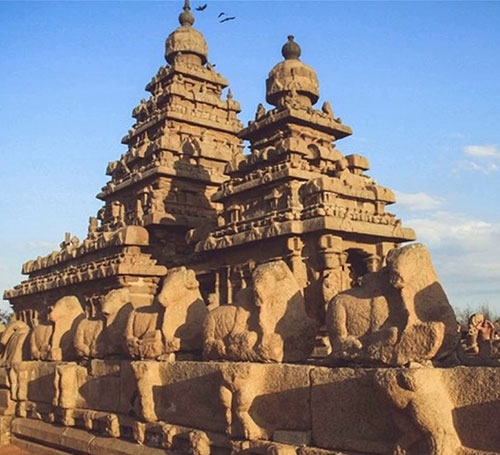Introduction:
Tamil Nadu, a southern state in India, is renowned for its rich cultural heritage and architectural marvels. One such gem is the Group of Monuments at Mahabalipuram, a UNESCO World Heritage site. Located along the shores of the Bay of Bengal, this ancient temple complex showcases exquisite rock-cut temples, intricately carved sculptures, and structural brilliance. In this blog post, we will delve into the historical significance and breathtaking beauty of the Group of Monuments at Mahabalipuram.
Historical Background:
Mahabalipuram, also known as Mamallapuram, was a bustling port city during the Pallava dynasty in the 7th and 8th centuries. The Group of Monuments stands as a testament to the architectural prowess and artistic brilliance of the Pallava dynasty. The temples and rock-cut sculptures were built during the reign of Narasimhavarman I and Narasimhavarman II, who were enthusiastic patrons of art and architecture.
Arjuna’s Penance:
One of the most iconic and prominent attractions at Mahabalipuram is the masterpiece known as Arjuna’s Penance or Descent of the Ganges. This mammoth bas-relief sculpture, measuring approximately 96 feet in length and 43 feet in height, is carved on the face of two enormous adjoining boulders. It depicts scenes from the Hindu epic Mahabharata and showcases the mastery of the ancient sculptors.
Shore Temple:
The Shore Temple, overlooking the Bay of Bengal, is an architectural marvel that captivates visitors with its sheer beauty and elegance. Constructed with blocks of granite, this temple complex comprises three temples, two dedicated to Lord Shiva and one to Lord Vishnu. The intricate carvings on the temple walls, the pyramidal structure, and the serene ambiance make it a must-visit site for history enthusiasts and architecture lovers.
Five Rathas:
The Five Rathas, also known as the Pancha Pandava Rathas, are monolithic rock-cut temples representing the architectural style of different eras. These five magnificent chariot-like structures are dedicated to the five Pandava brothers from the Mahabharata epic. Each ratha showcases unique architectural elements and carvings, reflecting the distinct Dravidian architectural styles that evolved over centuries.
Varaha Cave Temple:
The Varaha Cave Temple is an architectural marvel known for its sculptural beauty. Carved out of a single rock, this temple is dedicated to Lord Vishnu and features exquisite carvings depicting various deities and mythical creatures. The intricate detailing and the lifelike expressions of the sculptures leave visitors in awe of the craftsmanship of the ancient artisans.
Krishna’s Butter Ball:
One of the intriguing attractions in Mahabalipuram is the massive granite boulder perched on a slope, famously known as Krishna’s Butter Ball. It appears to defy gravity, with its precarious position creating a sense of wonder and amusement. Visitors are often seen posing next to this colossal rock, showcasing its immensity.
Conclusion:
The Group of Monuments at Mahabalipuram is a treasure trove of ancient Indian art and architecture. It not only provides a glimpse into the rich history of the Pallava dynasty but also serves as a testimony to the exceptional skills of the artisans of that era. The rock-cut temples, bas-relief sculptures, and monolithic structures continue to awe and inspire visitors from all over the world. A visit to this UNESCO World Heritage site is a journey through time, where one can truly appreciate the magnificence and cultural significance of the Group of Monuments at Mahabalipuram.
